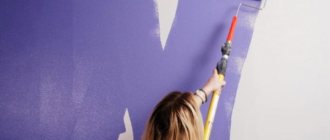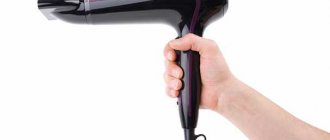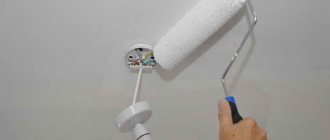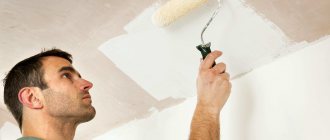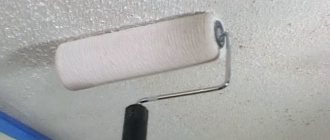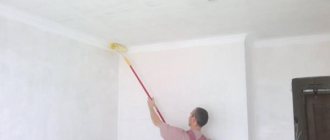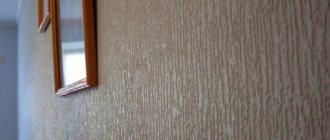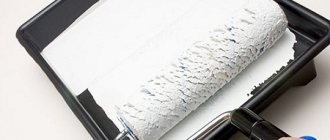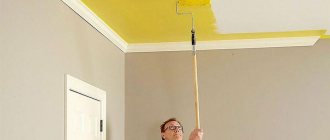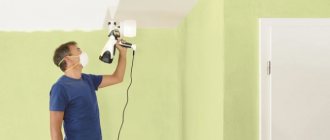Each of us at least once in our lives has had or will have to make repairs in our homes. And this process, as you know, requires a lot of investment not only in time, but also in effort, not to mention the financial side of the issue. Therefore, I want the result to be as good as possible, and spending time at home always brings pleasure and contributes to good rest.
Sometimes, to make your favorite bedroom or office feel cozier and fresher, all you need to do is change the curtains and paint the walls a different color. However, you also need to approach this wisely, thinking through everything down to the smallest detail. For example, now many are wondering whether it is possible to apply water-based paint over lime and whether the whitewash will begin to peel off over time.
Some claim that the surfaces of rooms painted in this way have retained their original appearance for many years, while others warn against such experiments. Since there is no clear answer, we will try to summarize the pros and cons and find out the best way to apply water-based emulsion to lime without harming the walls and, of course, your wallet.
Is it possible to paint a whitewashed surface with water-based paint?
Surely, when renovating an apartment or any other room, many people wonder whether it is possible to paint a whitewashed surface with water-based paint. Recently, lime finishing is becoming less and less common, because the fashion for this type of whitewash has long passed. In addition, the process of removing it is accompanied by a lot of dirt and debris. Therefore, there is often a desire not to remove the old coating from the walls, but to immediately paint it with water-based emulsion. We don’t argue that this option is possible, but only if:
- The surface of the ceiling or walls is not covered with defects in the form of pits, since the paint will only help to emphasize them;
- There is no fungus or mold on the old coating, because soon after painting these “guests” will make themselves felt again, and then it will not only be necessary to wash off the whitewashed walls, but also treat them with a special antiseptic solution;
- Traces of rust or water stains are visible on the whitewash, since the painting will not be perfect, and in those places covered with lime the color will again become darker (those who apply three or more layers are trying in vain);
- Lime, applied in a very thin layer, lies perfectly on the wall, while the painting over the entire surface is even and has no cracks or bumps;
- It holds tightly and is not prone to sagging or falling off, so painting will not be in vain.
Otherwise, if you pass water-based paint at least once over a whitewash that has the above-mentioned errors, it will simply get wet, become sticky, and during painting some particles of the wall will begin to attach to the roller, which will not only spoil the aesthetic appearance of the finish, but also your mood.
do not forget to prime the ceiling with a deep penetration primer
In order to avoid this, it is necessary to prepare the surface for repair work. First you need to use a spatula or scraper to remove all those places of whitewash that can be removed without any effort. Next, you should loosen the lime coating by soaking it with warm water, and then easily scrape off all the remaining fragments.
The next step in this process should be to completely clean the walls (ceiling). This can be done using a wrung out damp towel or a vacuum cleaner. And finally, the surface must be covered with a layer of primer, because then the water-based emulsion adheres more firmly to the whitewash. Only after doing all of the above is a positive result of the repair possible. Now apply water-based paints and don’t be afraid that soon all this will need to be redone.
Materials
- Chalk is the most popular option. The advantages of whitewashing with this material are low price and a perfectly white coating. The downside is its fragility: if you whitewash the ceiling with chalk, soon after the repair a nuisance may occur such as it falling off.
- Lime whitewash will mask minor irregularities well. Unlike chalk, this type of coating will last much longer. Lime can allow water to pass through itself, which is necessary in rooms with high humidity.
- Painting with water-based paint will cost more; the material is not used as economically as if painted with lime or chalk. There is no need to prepare the solution yourself - this material is sold ready-made. A wide range of shades allows you to realize any design ideas.
How to properly apply water-based emulsion to lime
You can use any water-based paint for whitewashing, however, be sure to pay attention to where you will use it. For a bathroom or kitchen, paint with a waterproof composition is best, and for other rooms all types.
Before starting work, the water-based emulsion is thoroughly mixed and, if necessary, water is added. To begin with, using a brush, you should apply water-based paint to the corners of the room, as well as other areas that cannot be reached with a roller. After this, you should paint the remaining areas, carefully distributing the paint to avoid the formation of drips. To satisfy you with the result, you need to apply at least two layers of water-based emulsion. However, the first layer must be completely dry before recoating.
As recommended by professionals, the best option is matte water-based paint, since it can easily mask all surface imperfections, and at the same time always looks impeccable in any color.
Useful tips from professional craftsmen
Important Be sure to take into account the characteristics of the room when choosing materials, tools and when making repairs. For example, in the bathroom it is better to use a moisture-resistant solution to protect the ceiling from the formation of fungus, otherwise the coating will soon begin to crumble rapidly
Typically 2-4 coats are required. Each subsequent layer must be applied when the previous one is completely dry.
It is important that the coating dries naturally. A beautiful, smooth ceiling is an important element in the perception of the overall appearance of the room. Read our articles on how to insulate, repair, level and putty the ceiling surface yourself.
Is it even possible?
Of course, no one can forbid you to paint your own ceiling or walls however you like, but what will be the result? Let's consider several scenarios in order to decide when you should absolutely not paint a whitewashed ceiling with water-based emulsion, and when you can still make an exception.
Option #1
There is a smooth and beautiful, but thick layer of lime or chalk on the ceiling. The hand does not rise to wash away, and the water is on the meter. Decided to paint it. Water-based paint applied to whitewash will soak it, and, since the coating is very thick, it will begin to:
- exfoliate,
- crumble,
- swell and fall in large pieces.
The ceiling will look miserable, and you will have to remove two layers of material, wasting time and money.
Conclusion: densely applied whitewash must be removed in order for the new coating to be of high quality and presentable in appearance; and if the whitewashed ceiling is clean, smooth and looks fresh, then maybe you shouldn’t touch it yet?
Option No. 2
The old coating was cracked in places, crumbled, and in some places swelled with bubbles. It was decided to clean the problem areas with a spatula, rub them with sandpaper and apply water-based paint over the remaining whitewash. Eventually:
- the ceiling will look like an abandoned battlefield: irregularities will immediately catch your eye;
- Surely, under the weight of fresh paint, the old, barely adhering layer of whitewash will begin to leave the surface.
- You will not like the result, and everything will have to be redone, and thoroughly.
Conclusion: if the old coating begins to deteriorate and crumble, then repainting it will not save it; You can paint with water-based paint only after the unusable layer has been completely removed.
Option No. 3
The ceiling is smooth, the painting material holds firmly, is not applied very thickly, but there are stains and stains from water on the surface (including traces of rust), sooty areas or signs of mold. You decide to simply paint with water-based paint to make the ceiling look clean. More likely:
- spots will appear even through two layers of paint, that is, the color in these areas will still be different from the rest, so the effect of “purity” will not work;
- the mold will “grow” and feel great, gradually developing new territories on the ceiling (and not only!);
- You may want to paint it again, but applying water-based paint on lime more than twice is a real provocation; the coating will crumble.
Conclusion: whitewash with traces of emerging life and dirt must be decisively removed!
Option No. 4
The ceiling was whitewashed only once, so there is little chalk on the surface; The coating is clean, smooth and does not crumble anywhere. Try this experiment: apply a little primer to a small area and let it dry. Now lightly scratch this area. Doesn't it fall out? This means you can paint with water-based emulsion!
Painting
Walls are painted in three layers: the first is primer, the next two are paint and varnish.
Painting is carried out in stripes overlapping each other at the junction in the manner of writing the letter “W”.
It is better to start work in daylight in the direction from the window in the opposite direction.
How to prepare a wall for painting
The preliminary stage includes plastering the uneven walls, then applying a layer of putty. After the materials have dried, the walls are washed with soapy water and a layer of primer is applied.
Popular Technologies
There are three main technologies for painting walls:
- brush;
- roller;
- spray gun.
Brush painting is an energy-intensive process with less than ideal results. The brush applies the paint unevenly and leaves streaks. However, you cannot do without a brush when processing areas in corners, at the joints with the ceiling, and around window frames. To do this, you need to choose a brush 10-15 cm wide, immerse it in liquid up to a third of the bristles, and use a mesh to get rid of excess on the brush.
Painting with a roller is a quick method that requires care in distributing the paint, first on the roller itself, then on the wall to avoid drips and splashes. To do this, use a special tray with a container for water emulsion and a place for rolling.
The use of a spray gun gives a high-quality layer without streaks, omissions, smudges, or color differences. The device is characterized by a large simultaneous coverage of the wall area, which speeds up the painting process.
How to paint over old paint
It is possible to update the interior without bothering to remove the old coating only if the old paint does not peel off. For a new coating with water-based emulsion, you need to sand the wall, apply a primer layer, and then start painting.
If the old paint is covered with cracks, chips, or peeling places, then for better adhesion of the new coating it must be removed. The water-dispersion coating can be washed off with a special solvent, or mechanically using a spatula, chisel, grinder, hair dryer, etc.
How to apply to different surfaces
You can paint wallpaper, textured plaster, plasterboard structures, and old finishes with oil paint with a water-dispersion emulsion. Each of these cases requires an individual solution.
You can paint wallpaper that is specially marked “for painting”!
Others may behave unpredictably under the coloring composition - get wet, change the degree of smoothness of the surface, peel off from the wall, absorb the paint unevenly, creating streaks.
Plasterboard walls are becoming more popular due to the variety of shapes they can create and their smooth surface.
This simplifies the process of wallpapering, but painting requires a number of manipulations.
Painting of drywall is possible when applied to a layer of finishing putty. The layer of putty here can be minimal, since it is intended not to level, but to create a uniform surface without seams and putty at the joints to obtain a uniform color in just one layer of paint.
You should not apply water-based emulsion to whitewashed surfaces - it is better to wash off the whitewash first. Chalk or lime compounds will begin to crack and peel under the paint, forcing you to repaint the walls once a year.
Dyeing process
Any surface needs preparation before finishing; in this case, you need to do the following:
- clean the ceiling from accumulated dust; This can be done using a vacuum cleaner or a well-wrung out damp cloth;
- put a layer of primer on a dry surface; it is possible to use a water-based emulsion diluted with water at least five times as a priming composition, but it is better to purchase a special deep penetration composition; let dry;
Now it's time to start painting. Tools to choose from: brushes and paint roller, spray gun.
Masking tape will be required in any case. Paper tape should be used to cover the perimeter of the walls just below the ceiling to protect them from paint.
Attention: before use, the water-based emulsion must be thoroughly mixed using a construction mixer or drill with an appropriate attachment.
If the household does not have a paint sprayer, then use a brush to paint the corners and joints (along the glued tape). Paint is poured into a special tray and the coat of a roller (with short pile or foam rubber) is soaked with it; excess liquid is removed by rolling it along the grooved surface of the tray.
Common mistakes made by DIYers
Beginners to renovation work can make a number of mistakes when painting a surface with water-based emulsion. In order not to repeat the mistakes of others, it is better to know them in advance:
- Painting without preparing the base. All dirt and defects remaining on the wall will appear after painting, and the result will be of poor quality;
- Wrong tool. It is better to choose a roller with a 6-7 mm pile; for the 2nd layer, a pile of 1.5 mm is suitable;
- Work with the brush in different directions; when the paint dries, strokes in different directions will become noticeable; you should always move the brush in one direction;
- Painting in one layer, applying one layer is difficult to obtain an even coating, it is better to do at least two;
- Paint on top of a non-dried surface, so as not to make a mistake, look at the packaging of the solution to see how long it should take to dry. Otherwise, the tool will stick to the surface and some of the paint will come off;
- Do not apply paint in hot weather or under bright sun. In hot weather, layers will dry too quickly, and in poor lighting it will be impossible to see flaws.
It is difficult to obtain an even coating when applying one layer; it is better to do at least two.
What difficulties might arise?
The question of whether it is possible to paint a ceiling over old whitewash with water-based paint is difficult to answer unequivocally. When making a positive decision, one cannot be absolutely sure of the success of this enterprise. Here are some arguments against:
- There is no guarantee that the seemingly strong old layer will not weaken in some places; The risk of getting a short-lived result still remains.
- Whitewash tends to get wet very quickly, becoming sticky; You may have to deal with such an unpleasant phenomenon as its smearing and small fragments sticking to the roller or brush.
- On a whitewashed ceiling it is difficult to see small irregularities or cracks under a layer of lime, but they will certainly make themselves felt after painting (the paint will highlight them).
Note: it is better to take a water-based emulsion with a matte effect; This coating smooths out and masks surface imperfections.
We all have to do cosmetic repairs to our home from time to time. And despite the abundance of finishing materials on the shelves of hardware stores, ordinary whitewashing of walls and ceilings is still very popular. Although this coating is short-lived, you can resort to it at least every year.
Recommendations from experts
- It is better to take paint from the middle price segment and refuse cheap, low-quality materials.
- Do not buy it at the market, but go to a hardware store where storage rules are followed.
- To avoid purchasing counterfeits, study reviews of manufacturers online, and check quality certificates in the store.
- Paint the ceiling with a long-pile roller - it gives a more even layer.
- Do not apply water-based emulsion in a thick layer. Distribute the composition evenly, if necessary, re-treat, waiting until the first layer has completely dried.
- If the emulsion was applied unevenly, after drying, you can correct the unevenness with sandpaper.
It turns out that making a ceiling in a room yourself is not difficult. To do this, you will need minimal knowledge about the most common methods and some free time. Read about how to install suspended, slatted, wooden, textured, plasterboard and fabric ceilings in our materials.
Advantages and disadvantages of whitewashing walls
Even a novice master can whitewash ceilings and walls with his own hands. Requirements for materials and tools are minimal. Let's try to evaluate the obvious advantages of this process:
- Cheapness. If it’s time to do repairs, but you have limited funds, whitewashing is the best solution.
- Simplicity. Even an untrained person can easily cope with the work.
- Accuracy. Although whitewashed walls are clearly inferior to modern decorative pasting - the same Venetian plaster, with the right approach it is possible to obtain an original matte surface. In addition, you can add dye to the whitewash, which will clearly benefit the design of the room.
- Environmental friendliness. The applied finish easily allows moisture to pass through and allows the walls to “breathe,” which cannot be said about tightly glued wallpaper or tiles.
- Active protection. Lime whitewash is not susceptible to fungus or mold because it is able to resist bacteria.
As for the disadvantages, the following should be highlighted:
- fragility - after a couple of years it is advisable to repeat the repair;
- uncomplicated appearance;
- There will be a lot of cleanup to do upon completion.
Stripping Tools
The choice of products and tools depends on the thickness of the whitewash layer and the degree of surface contamination:
- To remove a wide layer of limestone, use a sharp trowel. Moisten the wall or ceiling with water from a spray bottle in advance. Then use a spatula to scrape off the whitewash. To work, put on old clothes, tie up your hair and take a respirator, because lime gets dirty when wet.
- With a medium thickness of whitewash, use a roller with wet, tenacious bristles.
- To remove a thin layer of lime coating, purchase a grinding machine. With its help, you can clean the surface much faster.
Important! Protect your respiratory tract in advance with a respirator or gauze bandage, because the process is dusty. Lime particles enter the nasopharynx and larynx. This may cause allergies or respiratory problems. In particularly severe cases, pollution can even damage the lungs and cause pneumonia.
Do I need a primer?
If you want to get a strong and durable coating, you should not skip this step. Moreover, the primer is inexpensive. Its main purpose is to strengthen the base and improve the adhesion of paint to the wall. After treatment with a similar composition, a loose wall turns into a monolithic and durable coating.
The primer is able to fill the smallest pores, and the surface after its application looks smoother. The fact is that such compositions form a thin, durable film that prevents moisture from being absorbed from the paint. As a result, it lies flatter. Therefore, before applying water-based paint to lime, be sure to prime the surface.
Since it is sold in concentrated form, dilute it with water according to the instructions on the package. If the composition is too thick, streaks may form on the walls. It is better to add a little more liquid and treat the surface twice.
